Banner campaign
Latest

Introduction to Market Assessments – Video
Presentation
Markets play a central role in the lives and livelihoods of people. Sudden shocks such as natural disasters and conflict can have a strong negative impact on people’s capacity to access basic commodities. Market assessment and analysis should be an integral part of any emergency needs assessment to best...
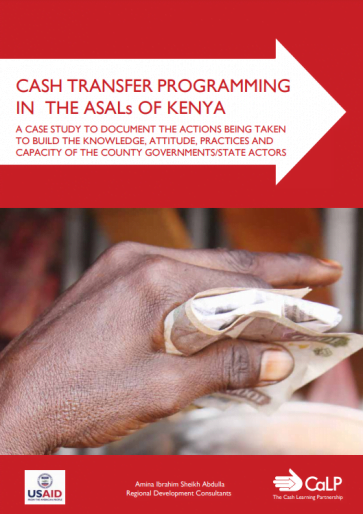
Cash Transfer Programming in the ASALs of Kenya
Case Study
The CALP Network commissioned a study to document the impact and lessons learned from its engagement with state actors in the ASAL counties. The study involved collection of data through secondary and primary sources. Given the focus of the project, a qualitative approach was deemed as most...

Part 1.2 The Minimum Expenditure Basket
Report
The Minimum Expenditure Basket (MEB) is defined as what a household requires in order to meet basic needs – on a regular or seasonal basis – and its average cost. Determining the MEB serves three functions: a) it is a holistic reflection of need as perceived by crisis affected populations, including...
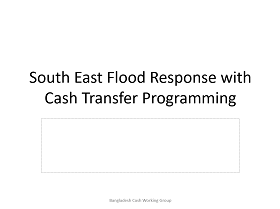
South East Flood Response with Cash Transfer Programming
Report
The biggest criteria is what needs is your cash transfer expected to cover. Consider below questions when setting your CTP amount. -How much will it cost for intended beneficiaries to purchase goods in local markets? -Are there any other goods and services on which HH may spend available cash? -Are prices...

A Review of Evidence of Humanitarian Cash Transfer Programming in Urban Areas
Report
Urban poor populations frequently experience disasters of varying typology and intensity. When set against a backdrop of poverty and marginalisation, their needs can be complex. As recent urban crises have pushed humanitarian agencies to respond in urban areas, this literature review examines the...

Expect the Unexpected: A Case Study of Impacts of Urban Food Vouchers in Somalia
Case Study
Beginning in early 2013, CRS implemented a series of food voucher programs, designed to meet the urgent food needs of vulnerable IDP and host households in urban communities. The vouchers were unconditional, but restricted to food purchases. The programs began in Kismayu in January 2013 (to December...

Are Public Works Programmes Effective in Reinforcing Social Protection Systems? Evidence from Northern Namibia
Report
This paper analyses the effectiveness of public works programmes (PWPs) in creating employment, reducing poverty and reinforcing the existing social protection system in Namibia. Using data and information from a survey conducted in northern Namibia, it is established that while public works programmes...
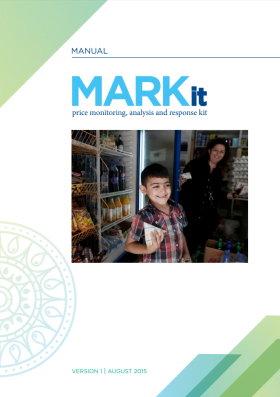
MARKit: Price monitoring, analysis and response kit
Guidelines and Tools
The Price Monitoring, Analysis and Response Kit (MARKit) was developed by representatives from the Local Regional Procurement (LRP) Learning Alliance to guide food assistance practitioners through the steps to monitor markets during the implementation of food assistance programs, and to ensure that...

Privacy Impact Assessment of UNHCR Cash Based Interventions
Report
In 2014, the Office of the United Nations High Commissioner for Refugees (UNHCR) commissioned Trilateral Research & Consulting to conduct Privacy Impact Assessments (PIAs) of two of its Cash-Based Interventions (CBIs) in middle-income countries. The purpose of the PIAs was to help UNHCR assess the...

AAP Minimum Standards for Complaints & Feedback
Guidelines and Tools
A complaints and feedback mechanism (CFM) is a formal mechanism for receiving and responding to complaints from people in communities where we implement programmes. The main objectives are to increase the influence of affected communities over programmes, ensure that incidences of dissatisfaction with the...
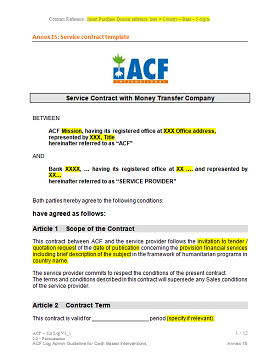
Annex 15: Service contract template
Report
Service Contract with Money Transfer Company

A Review of Evidence of Humanitarian Cash Transfer Programming in Urban Areas: Annexes
Report
Annexes to accompany the working paper ‘A review of evidence
of humanitarian cash transfer programming in urban areas”
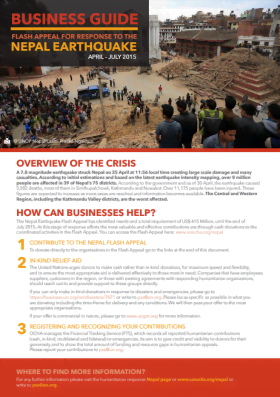
Business Guide – Flash appeal for response to the Nepal earthquake
Policy paper
An overview of the main humanitarian issues facing Nepal following the 2015 Earthquake, as well as indicators as to how businesses can assist with disaster response.

Guidance Notes: Cash Transfers in Livelihoods Programming- West Africa
Guidelines and Tools
A growing acceptance of cash transfers as an inter-sectorial tool is accompanied by a better understanding of this approach and its potential to break the cycle of poverty, after much discussion on the role cash transfers have to play in building resilience. In the Sahel, food security experts have...

Feasibility of cash transfer modalities in refugee settlements
Report
The main objective of this market assessment was to determine market functionality and the feasibility of cash transfer modality (and use of mobile money) among refugee settlements (Kyangwali, Kyaka II, Rwamwanja and Koboko) proposed for the cash transfer scale up in 2016. Survey households were randomly...
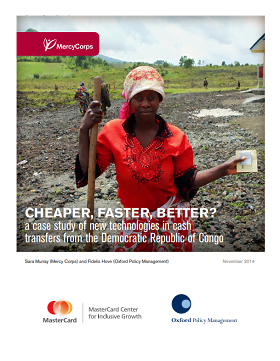
Cheaper, Faster, Better? A case study of new technologies in cash transfers from the Democratic Republic of Congo
Report
Over the past decade, there has been a growing consensus in the humanitarian community that cash, as compared to in-kind aid, is the best form of assistance to provide during an emergency. For families that have been displaced by a crisis or natural disaster, cash offers aid recipients more flexibility...

National Disaster Risk Reduction And Management Council
Report

Information and Communications Technology Response to the Liberia Ebola Crisis: Desk review and recommendations for private sector engagement
Report
An information and communication technology assessment recently conducted in Liberia by NetHope and USAID addresses the potential for digital payments in the response to Ebola. The documents looks into the digital payments landscape, describing the banking sector, use of mobile money and remittance firms....

Cash Transfer and Community Resilience Programming in South Central Somalia
Blog Post
The Building Resilience in Central Somalia (BRCiS) attempts to provide immediate humanitarian assistance as well as developing longer term local capacity through a combination of locally adapted cash-for-work and unconditional cash transfers.
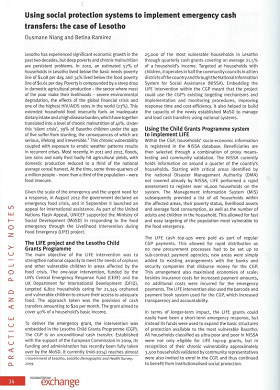
Using Social Protection Systems to Implement Emergency Cash Transfers: The case of Lesotho
Case Study
Lesotho has experienced significant economic growth in the past two decades, but deep poverty and chronic malnutrition are persistent problems. Given the scale of the emergency and the urgent need for a response, in August 2012 the government declared an emergency food crisis, and in September it...